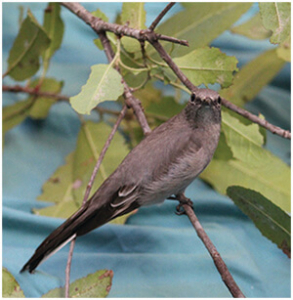Backyard Birds

Townsend’s Solitaire
By Denys Hemen, Hospital Manager
Having a yard is a privilege in the city. If you are fortunate enough to enjoy one at your home, it only takes a few minutes to put down your phone, be very still, and enjoy the nature around you. You may see tiny birds hiding in a bush, a squirrel high up in a tree, a soaring hawk or a gliding crow may pass overhead. Just going outside can bring you closer to nature. Nature is all around us and as humans develop lands farther and farther into open spaces, we are going to share our space more often with the creatures that live among us. One group of animals feeling the negative effects of human encroachment a little more than others are small songbirds. Most populations are on the decline and could use some help. Here are some easy ways to make your yard bird friendly and lend a hand to our feathered friends.
If you choose to have a bird feeder or waterer in your yard, please keep it clean. Take feeders down and discard leftover seed at least every two weeks, scrub with soapy water then rinse well. Make a solution of 9 parts water and 1 part bleach in a clean spray bottle and spray all parts. Leave the feeder sitting for ten minutes then rinse. Allow all items to air dry before refilling. If you provide water for wild birds the water should be changed daily, and the waterer should be sanitized in the same manner as the feeders every two weeks. If you ever see sick birds at your feeder, especially those with what looks like eye infections, take your feeder down, discard the seed, clean, sanitize, and leave it down for a week or two. Many bird diseases are easily transmitted through feeders and waterers.
Hummingbird feeders should be cleaned and sanitized every time they are refilled, which should be every 3-5 days to prevent mold from growing. Do not use detergent to clean, only use boiling water and a bottle brush. Sanitize the same way as previously described. The only formula that should be fed to hummingbirds is 4 parts water to 1-part white granulated sugar. Boil the water until the sugar is dissolved, then let the formula come to room temperature before refilling.
Planting native plants is a fun way to attract more birds to your yard. In Southern California, the fall and early winter are prime times to get native plants into the ground. Choosing which plants birds like best can be tricky on your own. At calscape.org, you can find plants that are native to your specific zip code. Descriptions are included of what each plant will attract- from bees to bugs, butterflies to birds!
If you have trees in or around your yard, try to “leave the leaves” as much as possible. Leaves provide cover for tiny insects that birds such as towhees and Northern Mockingbirds love to scratch around and hunt for. Fallen leaves also make excellent mulch for your native plants.
In the spring and summertime, quickly walk your yard to look for fledgling birds on the ground before letting your dog out. Many bird species have young that leave the nest before they can fly. These fledglings spend a few days on the ground before they build the strength to fly and are very vulnerable.
If you have windows that birds repeatedly fly into there are many ways to fix this issue. A great resource for remedies is abcbirds.org. Here you can find dozens of ways to “bird proof” your windows. From iridescent bird tape to streamers, all the items suggested by this non-profit organization have been tested and rated.
The last and most important way to make your yard bird friendly is to always keep your cats inside and never feed strays around your home. Outdoor cats kill over a billion birds in the US each year. Cats are the number one cause of the decline of native songbird populations.
If you ever find an injured bird, place the bird in a cardboard box that has air holes and is lined with a paper towel. Then take a picture for species ID by our staff later. Give our hospital a call at 310-458-WILD and we will be happy to help you.
